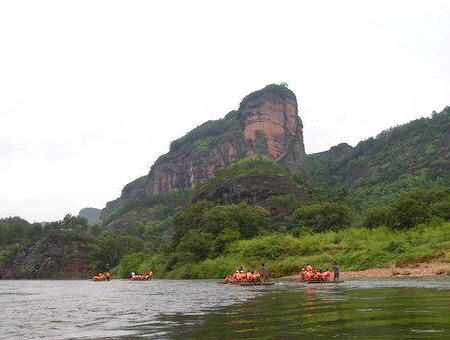 alt="Puer Surrounding Counties and Towns: Weekly & Special Local Markets Travel Guide"
/>
alt="Puer Surrounding Counties and Towns: Weekly & Special Local Markets Travel Guide"
/>
Huangnihe River in Qujing
Chinese Name:曲靖黄泥河
English Name: Huangnihe River in Qujing
Huangni River is one of the main tributaries on the northern bank of the Nanpan River, which is part of the Xijiang River system in the upper reaches of the Pearl River Basin. It is situated at the border between Yunnan (Dian) and Guizhou (Qian) provinces, specifically between Qujing City in Yunnan Province and Xingyi City in Qianxinan Prefecture, Guizhou Province. The river originates from Panjia Cave in Baishui Town, located in the northeastern part of Zhaoyang District, Qujing City, Yunnan Province, at the eastern foothills of the Wumeng Mountains. The section above Chajiang, stretching 172 kilometers, is referred to as the Kuaize River within Yunnan Province, while the 49-kilometer section below Chajiang serves as the boundary river between Yunnan and Guizhou. The Huangni River has a total length of 220 kilometers, a drainage area of 7,416 square kilometers, and an average flow rate of 172 cubic meters per second.
Geographical Description
The Huangni River flows between Luoping County in Qujing City, Yunnan Province, and Xingyi City in Qianxinan Prefecture, Guizhou Province, marking the border between Yunnan and Guizhou. Originating from Panjia Cave in Baishui Town, northeastern Zhaoyang District, Qujing City, the river begins at the eastern foothills of the Wumeng Mountains. It flows from west to southeast, then turns eastward, joining a larger tributary, the Xiao Huangni River, at Chajiang. After this confluence, it bends southwest and merges into the Nanpan River at Sanjiangkou in Xingyi City, Guizhou Province. The section above Chajiang is known as the Kuaize River, while the section below serves as the boundary between the two provinces.
Watershed Characteristics
The Huangni River basin is located between longitudes 103°55′ to 104°50′ E and latitudes 24°40′ to 25°40′ N. The watershed covers areas within Qujing City (urban area), Zhaoyang District, Luliang County, Fuyuan County, Shizong County, and Luoping County in Yunnan Province, as well as Xingyi City and Pan County in Guizhou Province, encompassing a total of six counties and two cities. The main tributaries include the Luoping River and the Xiao Huangni River. The basin’s topography is characterized by high elevations in the north and lower elevations in the south, with the highest point reaching 2,258 meters and the lowest point at the river mouth being 772 meters. The region is known for its well-developed karst formations, underground river sections, and numerous wells and springs. Mineral resources found in the area include molybdenum, coal, sulfur, and gypsum. The total population in the basin is approximately 208,700, predominantly engaged in agriculture. The agricultural population is about 188,400, with a total cultivated area of 174,300 mu (about 11,620 hectares). The level of water conservancy development is relatively low, with an effective irrigated area of only 21,900 mu (about 1,460 hectares), and a guaranteed irrigated area of 19,300 mu (about 1,287 hectares).
River Protection Initiatives
On June 24, 2017, Xia Hongmin, a member of the Standing Committee of the Guizhou Provincial Party Committee and Secretary of the Provincial Discipline Inspection Commission, led a “Protecting the Mother River” themed patrol of the Huangni River in Xingyi City, Qianxinan Prefecture. The event was hosted by Zou Bisheng, Deputy Secretary of the Party Committee and Executive Deputy Director of the Guizhou Provincial Public Security Department. The activity involved officials from the Provincial Discipline Inspection Commission, Public Security Department, Water Resources Department, Environmental Protection Department, Development and Reform Commission, Qianxinan Prefecture, Liupanshui City, as well as representatives of local cadres and residents along the river.
River and Lake Chiefs
The provincial-level river and lake chief responsible for the Huangni River is Chen Shaobo, a member of the Standing Committee of the Guizhou Provincial Party Committee and the Secretary General of the Provincial Party Committee.

 7 Days GolfingTour
7 Days GolfingTour
 8 Days Group Tour
8 Days Group Tour
 8 Days Yunnan Tour
8 Days Yunnan Tour
 7 Days Shangri La Hiking
7 Days Shangri La Hiking
 11 Days Yunnan Tour
11 Days Yunnan Tour
 6 Days Yuanyang Terraces
6 Days Yuanyang Terraces
 11 Days Yunnan Tour
11 Days Yunnan Tour
 8 Days South Yunnan
8 Days South Yunnan
 7 Days Tea Tour
7 Days Tea Tour
 8 Days Muslim Tour
8 Days Muslim Tour
 12 Days Self-Driving
12 Days Self-Driving
 4 Days Haba Climbing
4 Days Haba Climbing
 Tiger Leaping Gorge
Tiger Leaping Gorge
 Stone Forest
Stone Forest
 Yunnan-Tibet
Yunnan-Tibet
 Hani Rice Terraces
Hani Rice Terraces
 Kunming
Kunming
 Lijiang
Lijiang
 Shangri-la
Shangri-la
 Dali
Dali
 XishuangBanna
XishuangBanna
 Honghe
Honghe
 Kunming
Kunming
 Lijiang
Lijiang
 Shangri-la
Shangri-la
 Yuanyang Rice Terraces
Yuanyang Rice Terraces
 Nujiang
Nujiang
 XishuangBanna
XishuangBanna
 Spring City Golf
Spring City Golf
 Snow Mountain Golf
Snow Mountain Golf
 Stone Mountain Golf
Stone Mountain Golf













 What Our Customers Say?
What Our Customers Say?
